Ventuz Configuration
Table of Contents
Overview - Ventuz Configuration Editor
The Ventuz Configuration Editor enables the configuration of a Ventuz system for production. The Configuration Editor allows for the administration of multiple configurations and easy switching between them. The Ventuz Configuration Editor can be found in the Windows Start menu, or in the Tools menu of Ventuz Designer.
The editor is capable of configuring and controlling remote systems utilizing the Ventuz Machine Service. An installed, started, and accessible VMS is mandatory to configure all systems. The Ventuz Configuration is Project independent and configures all settings related to the Ventuz system. Most of the settings are hardware related but it also contains rendering, network and identification settings.
The Ventuz Configuration Editor consists of three pages: Project Browser, Configuration, Live.
Project Browser
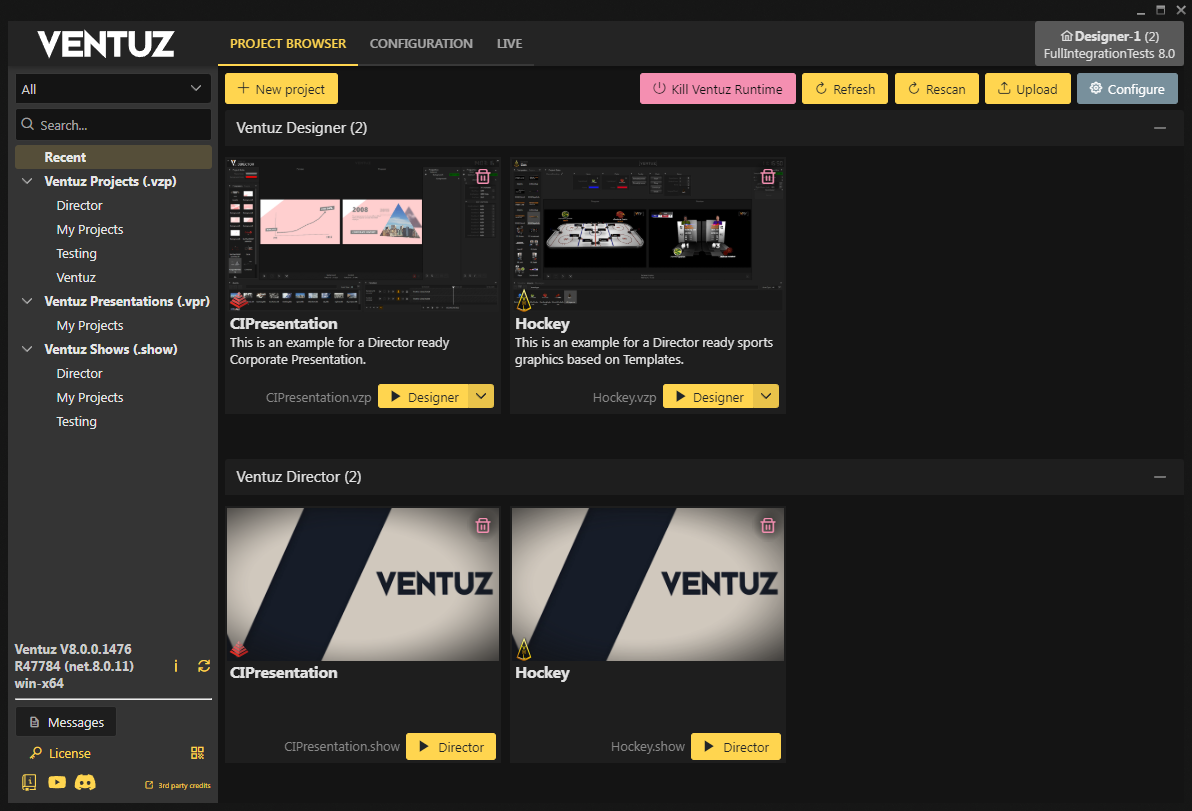
The Project Browser shows the used Designer Projects (.vzp), Director Shows (.show) and Runtime Presentations (.vpr). On the left side you can either see the recently used files or browse projects, shows, presentations based on their categories. Every displayed file type allows to be started with the associated application. This can be done clicking the button in the lower right corner of the displayed tiles. Presentations (.vpr) can only be started with the Ventuz Runtime, Director Shows (.show) can only be started with the Ventuz Director whereas Designer Projects (.vzp) can started with the Ventuz Designer or Director because Director Shows are always initially created based on Designer Projects. Clicking on a tile in the browser gives provides you further information for the associated file.
On top of the browser page you will find a row of buttons to perform certain actions:
| New project | Provides a dialog to configure and create a new Designer Project |
| Kill Ventuz Runtime | Allows to stop running Designer and Runtime (this button is only visible if either Designer or Runtime is running) |
| Refresh | Reloads the browser content. This can also be achieved by pressing F5 key. |
| Rescan | Starts s project scan in the configured VMS search paths and updates the browser content if new projects have been found. |
| Upload | Allows to upload VPR files to a remote machine where Ventuz is installed. |
| Configuration | Configure the project search paths for the VMS project scanner. |
Configuration
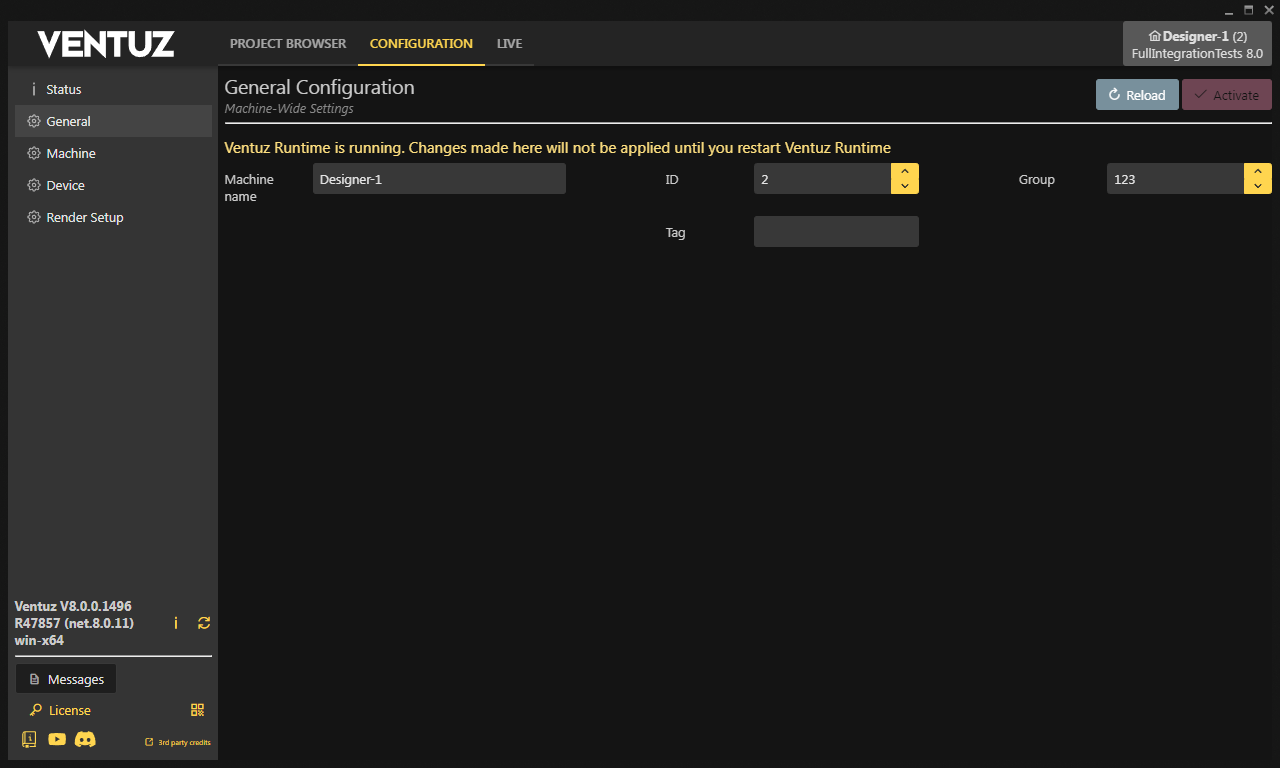
The Configuration page consists of the following sections:
Status: Here you can the basic information about the Ventuz Machine Service (running), the selected configurations and the (running) Runtime. At the bottom of this page you have the possibility to download log files for the different Ventuz applications.
Generall: Set the Name, numeric ID and Group values and Tag string here to identify this Ventuz machine in a network and assign it to a Ventuz Cluster if necessary.
Machine: Select or create new Machine Configurations here.
Device: Select or create new Device Configurations here.
Render Setup: Select or create a new Render Setup for an existing project or presentation here. It's also possible to start any of the listed projects and presentations.
Live
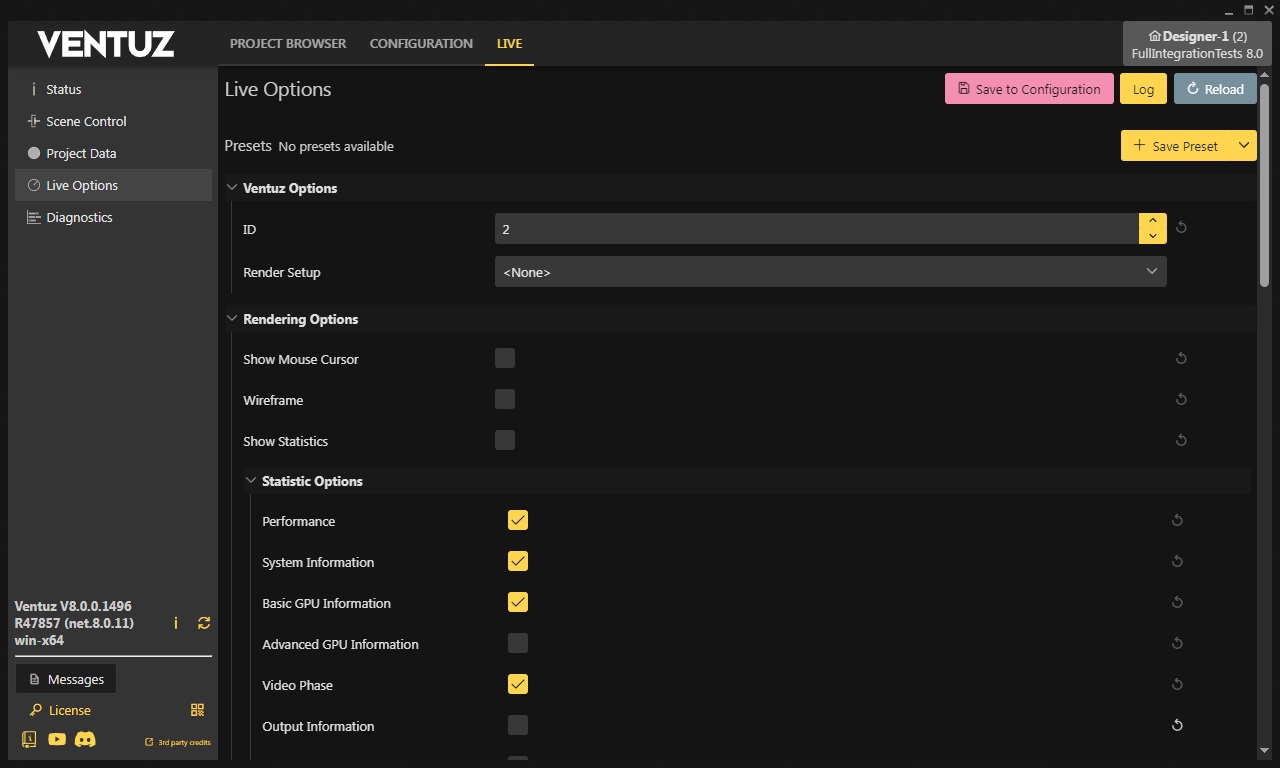
The Live page consists of the following sections:
Status: Here you can the basic information about the Ventuz Machine Service (running), the selected configurations and the (running) Runtime. At the bottom of this page you have the possibility to download log files for the different Ventuz applications.
Scene Control: This page gives you the possibility to to load scenes from the active project to the ScenePorts of the active LayoutScene.
Project Data: Here you can modify the Project Data of the active project and create presets from these data sets.
Live Options: This section allows to enable and modify certain parameters that can be changed during Ventuz Runtime is running without the need of changing the Machine Configuration or Device Configuration. These are e.g. the Statistics or some Rendering options. For a full description to Live Options.
Diagnostics: Here you can see the Performance Statistics as they are usually displayed on the render output. This comes handy if you do not have visual access to the render output.
Web Browser Configuration Editor
The browser based Web Configuration Editor contains most of the functionality of the stand-alone application. It is not necessary to have Ventuz locally installed, and it is also possible to use a tablet or a phone as device. It can also be installed as a Web app for quick access on most systems.
The address is as following:
| http://IP Address:22404 | Via the Web Browser you can access the Configuration Editor directly by entering the IP of the Ventuz machine and the Port |
| http://localhost:22404 | Open the Configuration Editor via your local VMS on your machine |
| http://192.168.4.25:22404 | sample address for the Web Configuration Editor on another machine |
The link to the Web Configuration Editor is also available as a QR code directly within the Configuration Editor or Launcher. Press the icon in the left side bar to open a pop-up with the link.
The following features are not supported when using a browser:
- Launching Designer or Director
- Project Properties or Maintenance
- Editing Shaping/Warping within Render Setups
- Editing Render Setups on touch screen devices is limited
The Web Configuration editor has been tested with Chrome for Windows and Android, Edge for Windows, Firefox for Windows, and Safari for iOS. Other browsers should work but might not support all features. We do not recommend using Microsoft Edge on the same machine as a running Ventuz Runtime because of GPU performance issues.
Machine Selection
The Machine Selector shows all machines discovered within the network. All these machines can be configured from your local or web Configuration Editor. The Ventuz Machine Service broadcasts its VMS signature periodically. The Machine Selector receives these messages and add the entries to the selector. Machines without VMS running can't be discovered and configured!
The entry with the House Icon on the left marks the local machine. The local machine is the default selection when the Ventuz Configuration Editor is started.
The selector automatically groups all machines with the same GroupID. To select a group click on the group label (here Group 2).
With the Search Bar it is possible to search in the available machines via the name, the ID or the Ventuz version and list the machines accordingly.
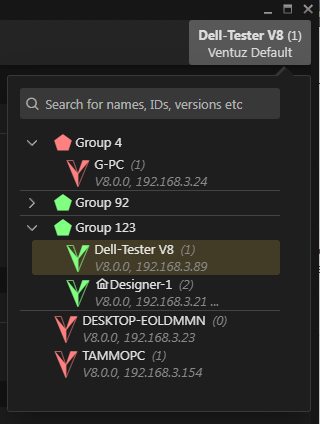
Each entry has a colored Ventuz icon. The color indicates the current state of the running Ventuz process on that particular machine:
 | OK | Ventuz is connected and running |
 | INIT | Ventuz is connected and running, though no project is loaded yet |
 | OFFLINE | Ventuz is not connected |
 | TIMEOUT | No VMS discovery message received |
Messages
By pressing the Log button in the Live Options the current status of all streams (audio & video) is logged in the message window.
This information is only visible if the message level is set to info or debug. The message level can be set using the dropdown menu.

Changing an output stream for example or setting a new resolution will be written to the Messages.
For a GPU output the resolution and refresh rate will be printed, the input streams and other devices are written to the Messages log as well. With a running system this good way to get an overview of the configured devices.
More critical events are logged as Warning or Error.
For SDI boards there are more detailed information:
Status : the state of the stream. The following states are possible
| Ready | waiting for input signal, ready to go |
| Presync, Syncing | stabilizing stream, synchronizing multiple streams together |
| Running | stream is running normally |
| Disabled | disabled either by the Live Video Node or by the software watchdog. |
| Bypass | bypass relays activated |
| Error | some error condition, see log for details. |
Queue : The number of frames queued and the length of the queue. This should be a low number for input streams and a high number for output streams. If Ventuz is temporarily to slow, the input queue fills up and the output queue dries out. If Ventuz recovers in time and renders fast enough, input queues will slowly be emptied and output queues get filled, no frame will get duplicated on the output and no frame will get dropped from the input.
Board Format : When creating the stream, the video engine can be configured to prefer either speed or quality. This effects the selection of a buffer format to be used for sending and receiving data to the video board. What format is actually chosen depends also on the hardware capabilities and if an alpha (key) channel is required.
| Name | Bits Per Pixel | Comment |
| YUV422 10 bit | 21.3 | best quality |
| YUV422 8 bit | 16 | best speed |
| YUVK4224 10 bit | 32 | best quality with alpha |
| YUVK4224 8 bit | 24 | best speed with alpha |
| RGBA 8 bit | 32 | used as quality option when YUVK4224 10 bit is not available |
| RGB 8 bit | 24 | used for some webcams (windows media foundation devices) |
| YUV422 8 bit with separate alpha | 24 | used for iVGA, same quality and speed as YUVK4224 8 bit |
Generally, RGB(A) is slightly better then 8 bit YUV(K) but worse and as slow as 10 bit YUV(K).
Buffers : The number of buffers allocated
Delay : The nominal delay of the stream. There are up to 3 kinds of delay:
| Input -> Ventuz | The delay from input to the Ventuz renderer |
| Ventuz -> Output | The delay from the Ventuz renderer to output |
| Input -> Output | The delay from the input and the output |
For instance, in the internal hardware keying without input mode, the delay from input to output is typically zero or one frame, while the delay from Ventuz to output is typically 3 to 4 frames. A zero delay is of course impossible, the deltacast keyer for example will shift the signal by around a hundred pixels. This counts as zero frames.
Status
General
The Status page from the Configuration or Live tab gives you detailed information about the current state of your selected machine(s).
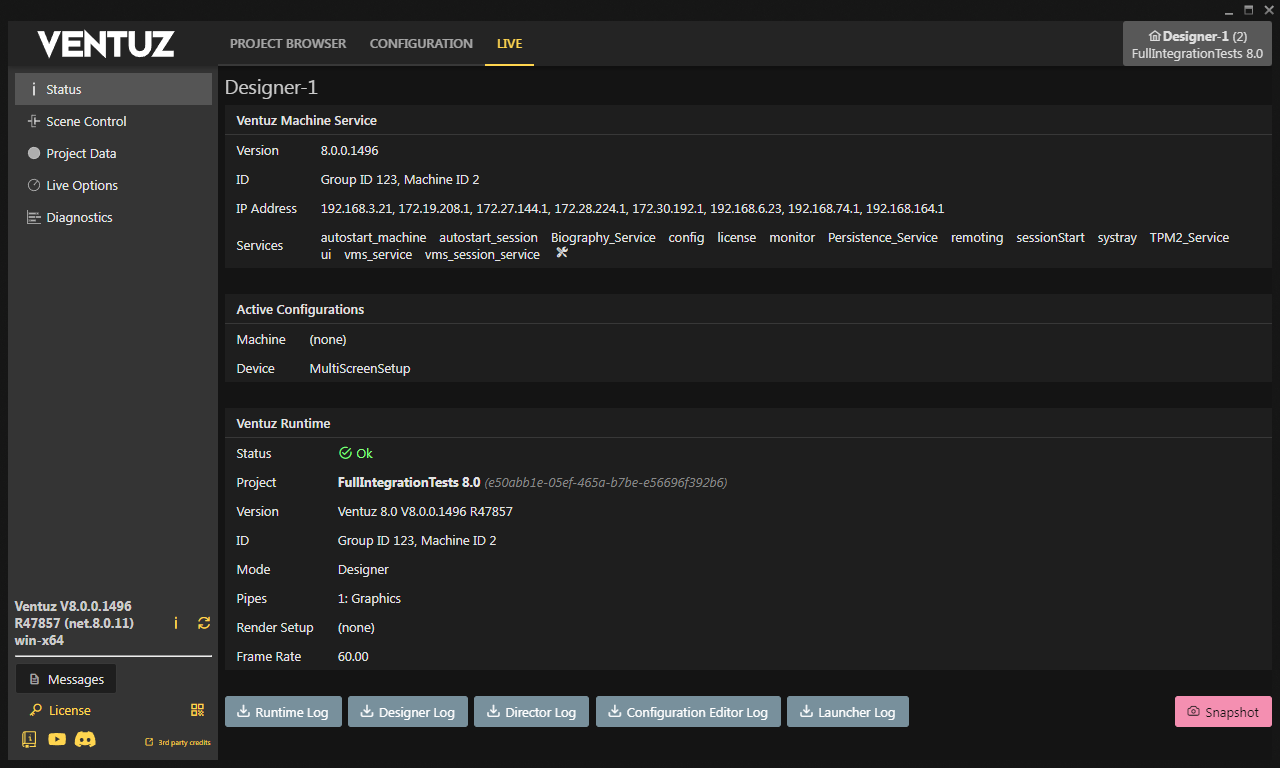
This includes:
- the ID and Group number
- the IP Address
- the currently running project
- the installed Ventuz version
- which product is running, e.g. Ventuz Designer
- and the output pipe with the current frame rate and other configuration settings
- overview of running VMS services and possibility to edit them
For more information on the different states that the VMS can be in, take a look at the VMS Documentation.
With the Snapshot button in the bottom right corner, a snapshot of the current Ventuz Runtime rendering will be displayed and is also downloadable.
Cluster Status
If a Group is selected in the Machine Selection tab, this window will display the information overview of each machine in parallel.
Logs Quick access
The Logs Quick access provides all the different application Logs. By pressing the Log button you can download the log file. They are also saved in the Ventuz configurations folder next to the Configuration Files on your harddrive.
With this you are able to monitor the logs with your tablet, smartphone or PC / laptop in your local network. Without the need of installing Ventuz on it.
License
License Manager
In the License section the system Ventuz license can be added, updated or unregistered.
This License Manager in the Configuration Editor has the some functionality as the standalone application installed with Ventuz.
With the Copy button all license information are copied to the clipboard.
Sometimes it might be necessary to press Update to reach out to the Ventuz License server to verificate your license after a change.
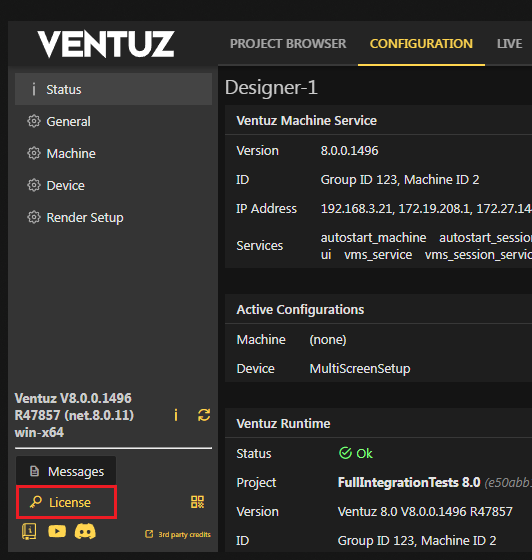
License Management
Registering & Activating
Depending on your purchased product you either received a Ventuz USB Dongle and License Certificate or simply a License Key via email. Please make sure to keep it in a safe place - you could be asked to send this info when solving license problems in the future. Also make sure to save your license key in case you have received it via e-mail.
If you have received a new dongle, it should contain an empty license, and you just have to click on Update License in order to download the latest license keys associated with this dongle.
When you are running your license for the first time or if your dongle does not contain any license keys, you must click on Enter License, and a new screen will appear (see below). The same goes with system and TPM licenses. You should fill in this form with your Licensee User, Company and Contact E-Mail information, and with the License Key information provided on your License Certificate.
After you fill in the form and press the Activate button, the activation process will create a license file on your dongle.
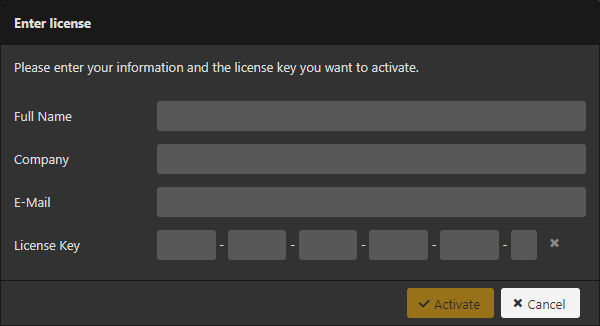
In order to activate a license, an active internet connection is required. Once the license has been activated, the connection is no longer required.If you purchased a dongle make sure the Dongle is attached during the activation process.
Please insert only one dongle. Licensing does not work with more than one dongle inserted into your computer. It is also recommended that you disconnect any external USB hard disk drives connected to your computer prior to licensing.
On dongle models prior to Ventuz 5 (Rounded, White and Red, check table above), license file is accessible from within Windows Explorer, so please make sure not to remove, rename, delete or otherwise modify this file. In addition, it is recommended that you create a backup of this file.
On Ventuz 5 dongle (Rounded, White and Red, check table above), this information is only accessible through the Ventuz License Manager, by clicking on the "Copy License Details" button, which copies the License and Licensee information to the clipboard so you can keep a backup copy. Nonetheless, it is strongly recommended that you keep your License certificate in a safe place as mentioned above.
Update License
If you already have a Ventuz License and want to add additional Ventuz Features you can start the Ventuz License Manager tool and update the Ventuz License with the newly purchased Ventuz Features.
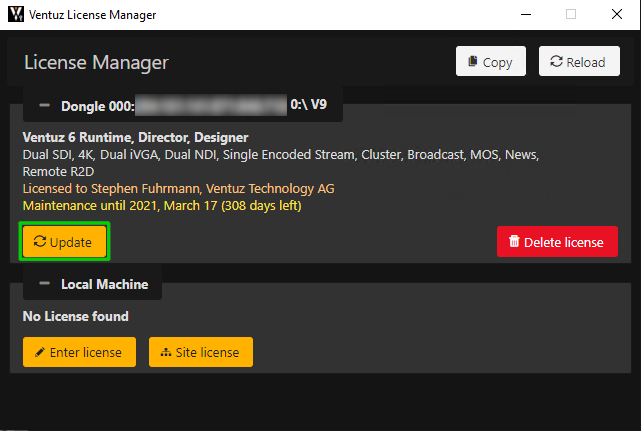
A green border around the Update button signals that the button needs to be pressed because the local license is not up to date as it has been modified on the license server (e.g. customer purchased a new feature like SDI out).
Expired License
If you try to run Ventuz Designer, Director or Runtime and are presented with the Ventuz License Manager with red text in the license panel this is an indication that your Maintenance period has expired and the version of Ventuz that you have installed is too new. In such a case please contact your Ventuz reseller or sales@ventuz.com. Highest available version under Maintenance indicates which is the most recent version of Ventuz that will run with your current license. You can download older versions here: https://www.ventuz.com/archive
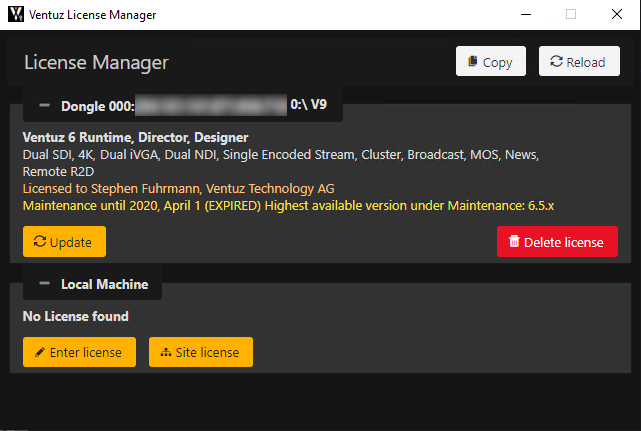
General Configuration
Overview
The General configuration tab contains information about the Ventuz Machine.

It defines the Machine Name of the machine as well its numeric ID and GroupID.
The ID determines which machine will be Master and which Client(s) in a Machine Cluster. The lowest ID will be set as Cluster Clock Master. The ID is also used to select the correct part to be rendered in the multi-machine Render Setup. With the Live Options, the ID can be changed while the runtime is active.
The GroupID must be set to a value greater than zero if a machine is part of a Cluster (group). Only machines with a GroupID can interchange their timing (cluster clock) to synchronize Remoting, animation and movie playback. For proper synchronization a valid Cluster Option is required.
The Tag is used by the Runtime to determine the Layout Scene that is to be used.
Configuration Files

The Machine Configuration and Device Configuration files are selectable and editable in the Configuration Editor.
New creates a new configuration file. It is possible to upload a file from the hard-disk, also a duplication of an existing configuration file can be done in the creation dialog. With Activate the selected configuration is activated and will be applied, also while the runtime is running.
With pressing the Cogwheel Icon the selected configuration will be opened in the editor. If you want to edit the configuration directly without the interface, you can edit the JSON file via the UI, by pressing the Paper Icon. With the Pencil Icon an existing, not activated, configuration can be renamed. With the next button the configuration file is saved to hard-disk. The Red Bin Icon deletes the configuration.
All Ventuz configuration files are stored in the system's public documents folder in the Ventuz8\Configuration directory. On most systems this path is:
C:\Users\Public\Documents\Ventuz8\Configuration\
Except the Render Setup files are stored within the Content\Project\RenderSetups folder structure within the Project.
If you upload your configuration file to a remote machine with creating a new configuration it will be saved at the remote machine locally in the same folder structure.
In the Ventuz configuration folder multiple files and folders are stored.
All Ventuz configuration files are human-readable and can be opened with a text editor.
| .vcfg | Ventuz Config | This file contains the Ventuz Config consisting of Machine Configuration, Device Configuration, Render Setups |
| .vdev | Device Configuration | The Device Configuration contains the configuration of IO devices. |
| .vmc | Machine Configuration | This file is project independent that handles and configures all settings related to the Ventuz system |
| .vren | Render Setups | This file contains the Render Setup created in the Render Setup Editor. |
| .vnetcfg | Network Configuration | This file contains the port numbers to be used for the Ventuz network protocols. |
Group Selection
If a Group / Cluster is selected the General Configuration section shows an overview of the machines configuration.

It is possible to see the activated configurations and Render Setups for each machine and the VMS status for each machine. The machines can be sorted by each category. With the arrow at the end of each machine line, the Configuration Editor will switch to this machine for editing configurations.
The red marked bar indicates that status or the configurations of both machines is not according to each other. In this case the runtime of the first machine is not running.